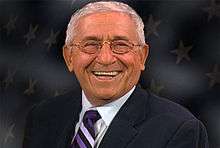Robin Seymour (DJ)

Robin Henry Seymour (born March 8, 1926, in Detroit, Michigan) is a former CKLW radio personality and host of the television series Teen Town (TV series) and Swingin' Time in Detroit. He started in radio as a child actor on the Lone Ranger Show and eventually became one of the country's longest-serving top ten disc jockeys.
The early years
In 1947, after a stint with the Armed Forces Radio Network during World War II, Seymour began an 18-year run with WKMH-AM 1310 in Dearborn, Michigan. He quickly became its most popular on-air personality. His warm, confident demeanor combined with his disc jockey style appealed to audiences of all ages and ethnicities in the Detroit area.
Seymour's afternoon "Bobbin' with Robin Show" featured all the top records on the music press sales charts. He pioneered rock-and-roll on the Detroit airwaves long before the Top 40 format emerged. In the mid-50s, Seymour was among the first of the nation's DJs to ask his listeners what they thought about new records. He was also one of the first white DJs in the city to play songs performed by African-American rhythm-and-blues and doo-wop artists. Seymour hosted some of the earliest "sock hops" and initiated commercial tie-ins with local record stores. He frequently hosted the popular "Robin Seymour's Original Rock 'n' Roll Revue" at the Fox Theater in Detroit.
In 1956, The Four Lads, accompanied by the Percy Faith Orchestra, recorded Seymour's theme song:
BOBBIN' WITH THE ROBBIN
[dramatic, upbeat orchestral fanfare lead-in]
Bobbin' with the Robin!
(doo-doo-do-doo-do-do-duh!)
Hob-nobbin' with the Robin!
(doo-doo-do-doo-do-do-duh!)
Bob-bobbin' with the Robin!
(doo-doo-do-doo-do-do-duh!)
Everybody, fly sky high!
[orchestral interlude, usually accompanied by a Seymour voice over intro of his show, rapidly spoken with high energy in his typical style reflecting the norm of Top 40 radio in those days; e.g., "Yeah, and this is the big, bad bird and for the next three hours we're gonna be bobbin' with Robin! All the hits, everything new and everything just for you! So, come on along and let's everybody have a ball."]
Bob-bobbin' with the Robin!
No-no more time for sobbin'
Go-go and let the mob in!
Everybody fly sky high!
Seymour had an uncanny sense for spotting new artists, helping introduce many of the big acts of the day via radio or stage. In 1953, Seymour was named "Disc Jockey of the Year" by Billboard, the top music trade magazine. The following year, he was given the same title by Hit Parader. In 1960, Seymour's show moved to the morning slot.
Teen Town
In 1963, Seymour and three business partners, including co-producer Art Cervi (Bozo The Clown), created Teen Town, a dance-party format similar to American Bandstand, with each show focusing on a different Detroit area high school. They secured advertisers and were eventually picked up by CKLW. A year and a half later, Teen Town morphed into Swingin' Time. The 30-minute weekday shows were broadcast live and the hour-long Saturday show was taped early in the day and aired at 3:00 pm.
Swingin' Time
Seymour continued his radio gig at WKMH through its transition to WKNR; however, after being given an ultimatum by WKMH to choose between his DJ job or his television appearances, he left the station to devote himself full-time to Swingin' Time. For a brief period at the end of 1965, Seymour was given radio slot on CKLW radio which he used to help promote Swingin' Time.
Promoting local bands
Seymour featured several established Motown artists on his show, including Frank Zappa and the Mothers of Invention, James Brown, Dionne Warwick, and Wayne Cochrane. He also introduced such up-and-coming local artists as Stevie Wonder, The Four Tops, Martha and the Vandellas, and The Supremes.
Seymour was the driving force behind KDB (Keep Detroit Beautiful) Teens in 1968. He spearheaded several beautification projects around Detroit with a kickoff concert at Detroit's Cobo Arena.
Life After Swingin' Time
When Seymour left Swingin' Time, he was replaced by another popular DJ, Tom Shannon. By then, however, the show had lost its momentum and ended in 1969. Seymour left both broadcasting and Detroit in 1980 and moved to the Los Angeles area where he owned a successful video production company until 2013. Now in his nineties, he works part-time from his home in Phoenix, Arizona, and has attended several Detroit disc jockey reunions.